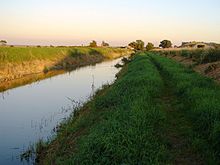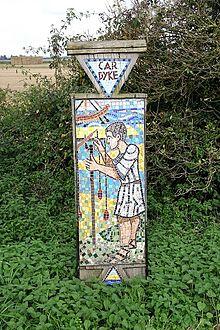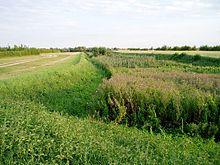The Car Dyke was, and to a large extent still is, an 85-mile (137 km) long ditch which runs along the western edge of the Fens in eastern England. It is generally accepted as being of Roman age and, for many centuries, to have been taken as marking the western edge of the Fens. There, the consensus begins to break down.
Likely purpose
In the eighteenth century, William Stukeley described it as a canal used for transporting goods and his idea is still promulgated: For example, excavations at Waterbeach in the 1990s by the archaeology unit of Cambridgeshire County Council found what were seen as the remains of a Roman-era boat and cargo of pottery from Horningsea.[1] This stretch has been protected as a scheduled ancient monument. Other archaeological investigations near Boston have given an indication of the dimensions: a navigable width of 12 metres (39 ft) and a depth of 2 metres (6.6 ft) were found during excavation.[2] Other excavations have found coal from the Midlands in use at a cluster of Roman-era coal-burning forges sited between Cambridge and The Wash and these provide evidence of trade and transport along the Car Dyke. Return cargoes were grain to supply the garrison at York, prepared for transport and storage by drying in coal kilns, and pottery.[3][4] At its northern end accounts of Roman Britain describe it as an extension of the Foss Dyke, an accepted transport route.[5][6] Near Morton, Lincolnshire, a boatload of dressed quarry stone, identified with the mediaeval period, has been discovered in the canal bed.[7]
In other parts, however, the topography suggests that its use as a canal was unlikely or at least difficult: the segment which ran, and to some extent still runs, through the Soke of Peterborough rises from the River Nene to a ridge at Eye then falls to the River Welland. This it does in steady gradients, quite unlike the characteristics of a canal designed for transport. Its course makes it clear that this outcome was carefully planned.[8] At some level sections in Lincolnshire it has causeways of never-disturbed ground crossing it and it passes in gradients, up and down the sides of slight ridges.[7] Given the length of the canal, however, modern surveyors suggest that the original engineers may not have been able to keep the canal at a constant level (due to surveying difficulties or lack of budget to excavate deeper). Natural barriers may therefore have been left in place to partition the canal into sections, maintaining the required depth of water, with goods transhipped or boats dragged across the barriers. They may also have been a deliberate precaution against the whole section drying out in summer.[7][9]

It acts as a catchwater drain in parts, intercepting runoff from the higher ground to the west:[10] evidence of seventeenth century improvements to form part of local drainage schemes has been identified, overlying material from the Roman period.[1] Conversely, the southern half of its passage through Lincolnshire and its northern end, near Washingborough, are accepted as having had a raised bank on each side; the one on the upland side would not be a feature well adapted to a catchwater drain.
It is possible to trace features which could be interpreted as boundaries all round The Fens which are either of Roman date or natural. In c.120 AD the Roman emperor Hadrian visited Britain and the sections dating from this period may be associated with his plan to settle the Fens.[10] The exception is in the south-east of the Fens where the landscape was manually strip mined for phosphate so destroying any evidence, before the days of detailed mapping and aerial photography. One conclusion, though given the conflicts in the surviving evidence one not reached by everyone, is that overall it was used primarily as a boundary, (as part of it in south Lincolnshire undoubtedly was in the medieval period) but that parts were adapted to serve also as a catchwater drain. Although possibly not originally intended as a means of transporting goods, archaeology has demonstrated that, in some parts at least, it was used by cargo-carrying vessels.
In his historical novel Imperial Governor, ISBN 0-432-14750-0, George Shipway maintains that Gaius Suetonius Paulinus, then governor of Britain, conceived draining the fens as a way of denying Icenian rebels a place to hide.
Route
The northern part of the Car Dyke from Lincoln to Peterborough is reasonably easy to follow. It is marked on the Ordnance Suvery map of Roman Britain[11][12] and was shown on the first edition maps by the Ordnance Survey produced in 1824.[13] Much of it is still marked on the modern 1:25,000 map and the 1:2,500 map.[14] However, the southern section from Peterborough to Waterbeach is not so easy to follow. The 2001 map of Roman Britain shows the dyke from Peterborough terminating to the north of Ramsey, with another isolated section running northwards from Waterbeach on the River Cam. Modern maps mark the section below Peterborough as Cnut's Dike, and Historic England argue that there is no proven link from Peterborough to Waterbeach, and therefore put its length at 57 miles (92 km).[15]
At the northern end, the first recognisable remains are to the north of the B1190 road through Washingborough, where the south bank runs between gardens and allotments. Material from the north bank was used to consruct new banks for the River Witham in the early 19th century,[13] as part of a project to replace the original locks at Kirkstead and Barlings with new locks at Stamp End and Bardney, authorised by an Act of Parliament obtained in 1808.[16] There are then six short sections which are listed as scheduled monuments, with gaps due to the construction of houses and a community centre on the line of the remains.[17] Its course then turns to the south-east, running parallel to the B1190, as it heads through Branston Booths, passing the end of Branston Delph and Carr-Dyke Farm, one of many similarly named farms along its length, to reach Potterhanworth Booths.[14] Much of its route has become part of the modern land-drainage infrastructure, and so the remains are not particularly well preserved.[13]
It then heads broadly southwards across open countryside and forms the eastern boundary of Potterhanworth Wood. In Nocton Fen it passes to the east of the site of Nocton Park Priory,[18] and then there is another scheduled section, bordered to the west by Nocton Woood, and connected to Nocton Delph, which flows eastwards to the River Witham.[19] In Metheringham Fen it turns to the east, and there are two short scheduled section after Blankney Wood, divided by the buildings of Oak Tree Farm.[20] It then resumes its southward passage, and after Carrdyke Farm, there is another scheduled section.[21] It passes to the east of Martin and the western end of Timberland Delph, before following a large S-shaped course to the east of Timberland.
Fens Waterways Link

The section between the rivers Nene and Welland may be restored to navigation as a section of the new Fens Waterways Link for leisure craft. An engineering study has been made, but because of concerns for its historic status it is not the preferred route, with the Cat's Water Drain being the other considered option.[22][23]
See also
- List of Roman canals
Footnotes
- ^ a b "Car Dyke, Waterbeach". Cambridgeshire CC. Archived from the original on 12 October 2006. Retrieved 21 August 2006.
- ^ Bond, James (2007). "Canal construction, an introductory review". In Blair, John (ed.). Waterways and Canal Building in Medieval England. Oxford, England: Oxford University Press. p. 165. ISBN 978-0-19-921715-1.
- ^ Hatcher, John (1984). The History of the British coal industry. 1 (2002 ed.). Oxford, England: Oxford University Press. p. 17. ISBN 0-19-828282-6.
- ^ Forbes, R J (1966): Studies in Ancient Technology. Brill Academic Publishers, Boston, Mass. ISBN 90-04-00626-5.
- ^ Roman Britain (2001). Southampton, England: Ordnance Survey. ISBN 0-319-29029-8
- ^ a b Ransom, P J G (1979). The Archaeology of Canals. Tadworth, England: The Worlds Work. pp. 9–10. ISBN 0-437-14400-3.
- ^ a b c Bond (2007: 167)
- ^ Pryor, Arnold. The Car Dyke p.24 in Durobrivae A Review of Nene Valley Archaeology: 6. Nene Valley Research Committee. (1978) ISSN 0307-7756.
- ^ Cook, Hadrian; Williamson, Tom (2001). Water Management in the English Landscape. Edinburgh University Press. p. 118. ISBN 1-85331-206-1.
- ^ a b Bond (2007: 166)
- ^ Simmons 1979, p. 183.
- ^ Roman Britain (Map). Ordnance Survey. 2001.
- ^ a b c "Car Dyke in Lincolnshire". Lincs to the past. 2012. Archived from the original on 11 November 2020.
- ^ a b Ordnance Survey, 1:25,000 and 1:2,500 maps
- ^ Historic England. "Section of the Car Dyke between Whitepost Road and Fen Bridge (1021133)". National Heritage List for England. Retrieved 10 February 2021.
- ^ Boyes & Russell 1977, p. 162.
- ^ Historic England. "Car Dyke between Washingborough and Common Square (1004923)". National Heritage List for England. Retrieved 11 February 2021.
- ^ Historic England. "Nocton Park Priory on Abbey Hill (1018898)". National Heritage List for England. Retrieved 11 February 2021.
- ^ Historic England. "Car Dyke in Nocton Wood (1004924)". National Heritage List for England. Retrieved 11 February 2021.
- ^ Historic England. "Car Dyke SE of Blankney Wood (1005484)". National Heritage List for England. Retrieved 11 February 2021.
- ^ Historic England. "Car Dyke at Linwood Hall (1004925)". National Heritage List for England. Retrieved 11 February 2021.
- ^ "Fens Waterways Link Supporting Report 1: Navigation" (PDF). Environment Agency. 2004. Archived from the original (PDF) on 28 June 2007. Retrieved 15 December 2010. archive
- ^ "Fens Waterways Link Supporting Report 3: Engineering" (PDF). Environment Agency. 2004. Archived from the original (PDF) on 28 September 2007. Retrieved 5 January 2008.
References
- Boyes, John; Russell, Ronald (1977). The Canals of Eastern England. David and Charles. ISBN 978-0-7153-7415-3.
- Macaulay, S.; Reynolds, T. (1993). Excavation and Site Management at Cambridgeshire Car Dyke, Waterbeach (TL 495,645). Fenland Research No 8. ISSN 0268-263X.
- Phillips, C. W., ed. (1970). The Fenland in Roman Times. Royal Geographical Society. ISBN 978-0-902447-02-8.
- Simmons, B. B. (1979). The Lincolnshire Car Dyke: Navigation or Drainage?. Britannia. vol. 10. Society for the Promotion of Roman Studies. pp. 183–196. doi:10.2307/526055.
External links
